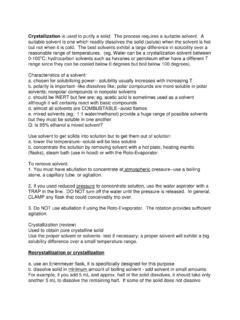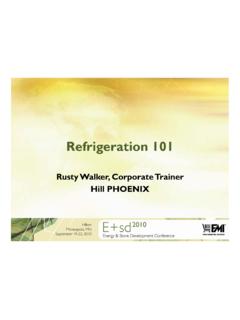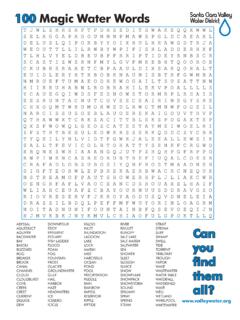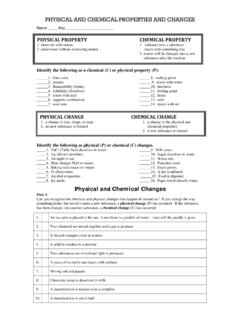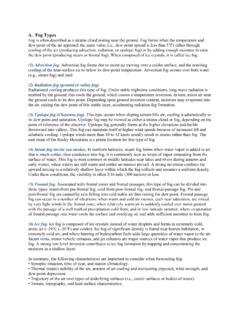Transcription of MOLLIER DIAGRAM - Luleå University of Technology
1 MOLLIER DIAGRAM . Dew Point - Tdp The Dew Point is the temperature at which water vapor starts to condense out of the air, the temperature at which air becomes completely saturated. Above this temperature the moisture will stay in the air. If the dew-point temperature is close to the air temperature, the relative humidity is high, and if the dew point is well below the air temperature, the relative humidity is low. The Dew Point temperature can be measured by filling a metal can with water and ice cubes. Stir by a thermometer and watch the outside of the can. When the vapor in the air starts to condensate on the outside of the can, the temperature on the thermometer is pretty close to the dew point of the actual air. The dew point temperature can be read by following a vertical line from the state-point to the saturation line. Dew point is represented along the 100% relative humidity line in the MOLLIER DIAGRAM .
2 Dry-Bulb Temperature - Tdb Dry bulb temperature is usually referred to as air temperature, is the air property that is most common used. When people refer to the temperature of the air, they are normally referring to its dry bulb temperature. Dry-bulb temperature - Tdb, can be measured by using a normal thermometer. The dry-bulb temperature is an indicator of heat content and is shown along the left axis of the MOLLIER DIAGRAM . The horizontal lines extending from this axis are constant-temperature lines. Wet-Bulb Temperature - Twb Wet bulb temperature is associated with the moisture content of the air. Wet bulb temperature can be measured with a thermometer that has the bulb covered with a water -moistened bandage with air flowing over the thermometer. Wet bulb temperatures are always lower than dry bulb temperatures but they will be identical with 100% relative humidity in the air (the air is at the saturation line).
3 On the MOLLIER DIAGRAM , the wet-bulb lines slope a little upward to the left (dotted lines). Heating of Air Cooling and Dehumidfying Air Mixing of Air of different Conditions The heat balance for the mix can be expressed as: LA hA + LC hC = (LA + LC)hB. where L = mixing rate h = enthalpy of the air The moisture balance for the mix can be expressed as: LA xA + LC xC = (LA + LC) xB. where x = water content in the air Calculating the mixture variables xB and hB makes it possible to calculate the mixing temperature tB. Humidifying , Adding Steam or water (liquid). Psychrometric Chart The psychrometric chart is a variant of the MOLLIER DIAGRAM used in some parts of the world. The process transforming a MOLLIER DIAGRAM to a psychrometric chart is shown below. First it has to be reflected in a vertical mirror, then rotated 90 degrees. Evaporation from water Surfaces The amount of evaporated water can be expressed as.
4 A hc m evap ( xs x ). cp . m evap = amount of evaporated water (kg/s). A = water surface area (m2). h c = heat transfer coefficient (W/m2 K). c p = mean specific heat for moist air (J/kg K). x = humidity ratio in the air (kg/kg). x s = humidity ratio in saturated air at the same temperature as the water surface (kg/kg). Problem 6 (page 22). An indoor pool evaporates a certain amount of water , which is removed by a dehumidifier to maintain +25 C, =70% RH in the room (state 1 in figure). The dehumidifier, shown in figure, is a refrigeration cycle in which moist air flowing over the evaporator cools such that liquid water drops out, and the air continues flowing over the condenser. The air after the evaporator (state 2). has a temperature of +14 C. For an air flow of 0,10 kg/s dry air the unit has a coefficient of performance COPR =3,0. Total pressure in the room is constant 101325 Pa.
5 Calculate a) the amount of water that evaporates from the pool ( steady state). b) the compressor work input c) the absolute humidity and enthalpy (kJ/kg of dry air) for the air as it returns to the room (state 3 in figure). 1 3. Evaporator Condenser 2. water liquid Problem dryer Heating coil Outdoor air B C. A. +. T=+14 C. =60% RH. Wood dryer Capacity: 500 kg/h D. T=+40 C. =90% RH. 3/h Volume flow of moist air: 20100 m TA = 14o C , A = 60 % RH. pws = 1599 Pa, pw = 1599 = Pa x A = = kg / kg 101325 hA = 14 + (2502 + 14) = kJ / kg TD = 40o C , D = 90 % RH. pws = 7375 Pa, pw = 7375 = Pa xD = = kg / kg 101325 hD = 40 + (2502 + 40) = kJ / kg Ru mT ( + 40). V= M = = m3. p m + = = = kg / m3. V . m moist air = V = 20100 = kg / h . m moist air m dry air = = = kg / h + x + adiabatic conditions for the dryer hC = hD.. m water in dryer = m dry air ( xD xC ).
6 M water in dryer 500. xC = xD . = = kg / kg m dry air hC = hD = kJ / kg Heating coil xB = xC = kg / kg Mixing rate of outdoor air (mix). xB = (mix) x A + (1 mix) xD. xB xD mix = = = x A xD Amount of outdoor air : . m dry air , A = = kg / h hB = (mix) hA + (1 mix) hD. hB = + (1 ) = kJ / kg Q heating coil = m dry air (hC hB ) = ( ) = 456 kW. 3600. Problem dryer with heat pump Cooling coil Outdoor air B C D. A Condenser - T=+14 C. =60% RH. Wood dryer Capacity: 500 kg/h F E. Evaporator T=+40 C. T=+28 C =90% RH. 3/h Volume flow of moist air: 20100 m TA = 14o C , A = 60 % RH. pws = 1599 Pa, pw = 1599 = Pa xA = = kg / kg 101325 hA = 14 + (2502 + 14) = kJ / kg TE = 40o C , E = 90 % RH. pws = 7375 Pa, pw = 7375 = Pa xE = = kg / kg 101325 hE = 40 + (2502 + 40) = kJ / kg TF = 28o C , F = 100 % RH (assumed ). pws = 3780 Pa, pw = 3780 Pa (< Pa condensation occur ).
7 3780. xF = = kg / kg 101325 3780. hF = 28 + (2502 + 28) = kJ / kg Ru mT ( + 40). V= M = = m3. p m + = = = kg / m3. V . m moist air = V = 20100 = kg / h . m moist air m dry air = = = kg / h + x + adiabatic conditions for the dryer hD = hE.. m water in dryer = m dry air ( xE xD ).. m water in dryer 500. xD = xE . = = kg / kg m dry air hD = hE = kJ / kg Cooling coil xC = xD = kg / kg (no condensation occur ). Heat transfer to heat pump (evaporator ). Q L = m dry air (hE hF ) =. ( ) = kW. 3600. Condenser xB = xC = kg / kg Mixing rate of outdoor air (mix). xB = (mix) x A + (1 mix) xF. xB xF mix = = = x A xF Amount of outdoor air : . m dry air , A = = kg / h hB = (mix) hA + (1 mix) hF. hB = + (1 ) = kJ / kg . Q condenser = m dry air (hC hB ) = need to calculate hC. From (log P h) DIAGRAM for R717 we read after evaporator : h1 = 1780 kJ / kg (1460 kJ / kg from CATT 2).
8 After compressor : h2 = 2100 kJ / kg (1776 kJ / kg from CATT 2). after condenser : h3 = 1010 kJ / kg ( kJ / kg from CATT 2). before evaporator : h4 = h3 = 1010 kJ / kg ( kJ / kg from CATT 2).. Q L = m R 717 (h1 h4 ).. QL m R 717 = = = kg / s (h1 h4 ) (1780 1010). Work input to compressor : . W comp = m R 717 (h2 h1 ) = (2100 1780) = 154 kW. Heat transfer from condenser : . Q H = m R 717 (h2 h3 ) = (2100 1010) = kW. this heat will heat the mixed air flow . Q H = m dry air (hC hB ).. QH hC = . + hB =. + = kJ / kg m dry air 3600. Adiabatic conditions in dryer hD = hE = kJ / kg Q cooling coil = m dry air (hC hD ) = ( ) = 73 kW. 3600. Wood dryer using only outdoor air consumes about 456 kW of heat Wood dryer with a mechanical heat pump consumes electricity 154 kW and deliviers 75 kW of heat ps: no efficiency have been included.

